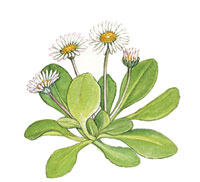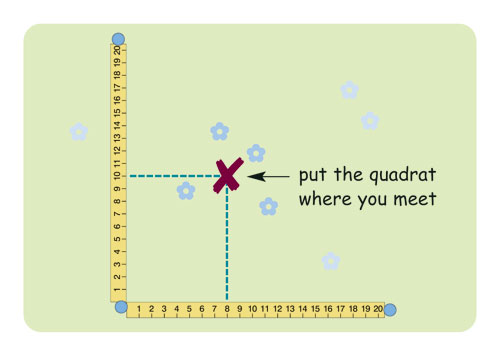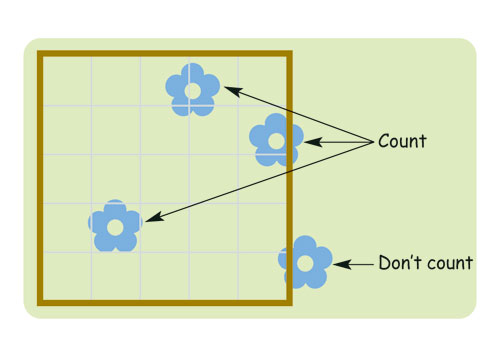Biodiversity in your backyard!
Class practical
Introduce fieldwork techniques in your school grounds with the support of the Field Studies Council key Playing field plants.
Random sampling allows you to make an estimate of the populations of different species in any area. It should eliminate sampling bias introduced by the sampler selecting areas that look interesting or easier to count.
Students may well be surprised by the biodiversity in an area they think of as ‘grass’. There is scope for students to develop and investigate hypotheses about plant distribution based on observations and measurements of factors such as soil, moisture, light intensity and wind speed.
Observations of human or other animal activity in the area, and background information about the characteristics of common playing field plants, provide further starting-points for developing hypotheses to test over short or long time-scales.
Lesson organisation
Students working in groups of three or four can each take a role in the survey. Depending on your students, it should be possible to carry out your survey of one or two areas of the school grounds in one lesson. Presenting and analysing the results could be completed in the next lesson.
Collecting data to investigate hypotheses might be spread over several weeks. Each time the students survey the area, they will be more efficient as they become more familiar with the technique and the species present.
Apparatus and Chemicals
For each group of students:
Quadrat – a wire frame 0.25 m x 0.25 m, or
0.5 m x 0.5 m
Key to plants - link to FSC website where you can buy this
Clipboard, 1
Pencil, 1
Record sheet – devised by teacher or students
For the class – set up by technician/ teacher:
Tape measure, 20 m, 2 (or string marked into metres)
Number cards, 1-20, in each of two bags (or bowls or buckets)
or 20-sided dice, 2 (ask someone who plays war games or fantasy role-play games)
Pinboard, or sheet of cardboard (for step 1) with sticky tape or pins to attach plants to the board
Health & Safety and Technical notes
See notes below for planning work outdoors (Note 2) or the CLEAPSS Supplementary Risk Assessment
(SRA 08), dated October 2006.
1 Choosing your quadrat: A quadrat, not a ’quadrant‘, is a frame used for sampling an area and it is usually square. Smaller quadrats present a smaller number of species to be identified. However, groups taking 10 samples each with 0.5 m x 0.5 m quadrats will collect information about a more significant sample of the area. Students should be made aware that they should place a quadrat into a randomly selected square on a grid or drop it over their shoulder, rather than throw it.
2 Refer to the supplementary risk assessment (SRA 08) dated October 2006 from CLEAPSS for more details of hazards and control measures for working outdoors. This risk assessment advises that it is important to consider the following:
i How students are likely to behave when working outdoors; that the normal ratio for classrooms or laboratories may not be adequate to ensure safe working outdoors.
ii Provision for hand washing needs to be readily available whenever plants and soil are handled. You might consider the use of alcohol gels or other hand sanitisers with paper towels.
iii The low risk of diseases such as toxoplasmosis and toxocariasis from plants and soil contaminated by cat or dog faeces. Covering any cuts and grazes and ensuring that students do not eat snacks or sweets while working outdoors, as well as confirming thorough hand washing, reduce this risk.
iv The possibility of allergic reactions to substances encountered outdoors, such as pollen, plant sap, contact with leaves, insect bites and stings, or some hairy caterpillars. Be alert to the development of any allergic reactions or asthma symptoms, and deal with them according to your school’s normal policy.
v The risk of sunburn on sunny summer days if exposed for more than 20-30 minutes.
vi Risks of injury when using and carrying tools or heavy loads of unfamiliar equipment; this should be assessed for each individual in the specific environment.
vii Hazards such as building rubble, pot-holes in the ground, unsafe structures, or items such as broken glass and other litter which could be hidden in grass or soil. Check the area in advance and be aware of any such risks that could cause wounds or cause children to trip and fall. Remove the hazards or identify them with warning signs and keep students away from them.
3 Sample size: You can test whether your sample size is big enough by comparing the results from two groups sampling the same area. If their results are very similar, your sample size is big enough to be a good estimate of the populations in the area.
Ethical issues
It is useful to consider how the act of surveying the area and collecting plants might damage or change the environment surveyed. Although this is probably not an issue for a school playing field which is regularly mown and trampled in normal use, it would certainly be an issue for a natural or ‘wild’ area.
Procedure
SAFETY: Make a full risk assessment for the outdoor activity and put in place any necessary control measures.
Preparation
a Check the area where you will be working for hazards.
b Make a preliminary survey yourself to identify the most common plants (other than grass).
c Collect your equipment together and check it for hazards such as sharp edges. Consider attaching tags of brightly-coloured electrical tape to make it easier to locate equipment that gets ‘lost’ on the site.
d Organise your students in groups of three (or four), and identify their roles in the group.
Step 1 Preliminary observations
a Stand in the area to be surveyed and make a simple plan drawing of key features – the direction of north, any nearby buildings, large plants (trees and shrubs), favoured paths across the area, slopes,and so on. Include information about the use of adjacent land, and think about whether the site is open and exposed or sheltered by a belt of trees or buildings.
b Make a note of any clearly visible features in the grassland vegetation, such as areas of flowering plants, worn grass or darker vegetation.
Step 2 Identifying what species are present

c Give the students a quadrat per group. Place the quadrat on the ground. Ask students to look closely at the plants, and observe how many different plants they can see.
d Develop vocabulary to describe the differences between plants. These could be key botanical features such as leaf veins, sepals, or the arrangement of flower clusters, and the shapes of leaves, the patterns of attachment of leaves to stems, and the habit of the plant (ground-hugging, creeping, rosette, etc). The table on the inside of the FSC key Playing field plants will guide such observations, and help students use them to identify the main species of plants.
e Collect samples of the five most common plants (other than grass). Write their names on the board and ask each group to bring and attach a sample of each plant to the board.
Step 3 Sampling the area – a random sample
f Lay out your tape measures or marked string at right angles along two edges of the area to survey. Lay the two bags of numbers near the point where the tapes meet.
g With students working in threes, ask one student to hold the quadrat, a second to pick a number from the bag on one line, and the third to pick a number from the other bag on the other line. The, the students who have numbers should replace the numbers and walk to that number on their line. The student with the quadrat uses their colleagues as place markers, and places the quadrat where it is in line with both of them. Then all three can work together to identify the species in their quadrat and record the results.

h Send two students back to the bags on the lines to pick more numbers and randomly select the next quadrat position. Repeat step g.
i Each group should assess the contents of around 10 quadrats to get a reliable estimate of the species distribution.

Step 4 What to record
j In a preliminary investigation, or with younger students, a presence or absence of each species in each quadrat may be enough information. You can then collate the results to show the percentage of quadrats in which each species was found. This will give you a relative abundance of each species.
k With older students, or to provide data you can analyse with mathematical tools, you can make more accurate measures of frequency. For example, if your quadrat is divided with evenly spaced threads/ string to form 100 smaller squares, you can record the number of squares in which an example of a given species appears, to get a measure of relative frequency within the quadrat area.
Step 5 Analysing the results
l Use a spreadsheet to analyse the results; produce bar graphs or other plots of the data collected.
m The simplest analysis would be of the percentage of sample quadrats each species appears in.
n If you have information about frequency (or percentage cover), you can calculate the average frequency (or average percentage cover) of each species for each area sampled.
Teaching notes
It can be very rewarding with younger students simply to open their eyes to the diversity of plant species under their feet. Observational skills, and learning which features of plants are important when distinguishing one species from another, are significant basic skills.
The detail of the data you gather will depend on the investigation you are exploring.
A 20 m x 20 m survey area covers 400 m2. A 0.25 m quadrat covers 1/16 of a square metre and a 0.5 m quadrat covers 1/4 of a square metre. So, with 10 groups collecting data from 10 quadrats each (100 quadrats surveyed), the group will have sampled 6.25 m2 with 0.25 m quadrats (about 1.6% of the area), or 25 m2 with 0.5 m quadrats (6.25% of the area). (Note 3.)
A random sample will give you descriptions characterising an area. This is useful if you want to compare two contrasting habitats. You could make random samples on two different areas of grassland in the school – such as the playing field and any open areas that get less foot traffic, or two different parts of the playing field to see if there are any differences.
Using the method given here for selecting your random sample point means that two groups may survey the same square metre. For introductory exercises this should not matter, but for more thorough investigations you could keep track of the areas sampled and ensure you do not survey any sample square twice.
There are several methods of quantifying biodiversity – apart from comparing a simple list of the number of species identified in each area. One measure is ‘species richness’. Others include ‘range-size rarity’ and ‘taxic richness’. See links below, or make a wider internet search.
You could survey to answer questions such as: Are there more daisies in mown or unmown grass? Are there more ribwort plantains where the grass is less trampled? Alternatively, after identifying differences in distribution of species between two areas, you can start to develop hypotheses that might explain the different distributions. These might depend on being able to collect further data about the areas. For example: is the soil wetter where we find more buttercups?
You could collect and collate information about the plants in the field, and maintain a database of distribution information (with photographs) over a number of years.
This kind of random sampling will probably not reveal any trends or changes across an area, such as differences near to or far from a regular walkway where plants are trampled. However, there are systematic sampling techniques that allow you to investigate changes along a line from one part of an area to another – such as a line transect or a belt transect. A good guide to ecological techniques will explain these techniques in more detail.
Downloads and Student questions
Download a simple work sheet ![]() Biodiversity in your backyard (110 KB) with questions and answers.
Biodiversity in your backyard (110 KB) with questions and answers.
Some questions to think about:
1 What are the 5 main species in each area?
2 What do you think are the reasons for any differences?
3 How would you investigate these differences further?
4 What has surprised you most about the diversity of plants on your school playing field?
Health & Safety checked, October 2008
Web links
http://www.field-studies-council.org/publications/pubsinfo.aspx?Code=OP97
Details of the Field Studies Council key to Playing field plants. This will be a great help in identifying the main plants and provides supplementary information about the plants to support hypothesis development and suggestions for further work.
http://www.field-studies-council.org/outdoorscience/diy.htm
Part of the London Outdoor Science project – with details of how to make and use your own fieldwork equipment.
http://www.field-studies-council.org/resources/index.aspx
The index to all the Field Studies Council on-line resources.
http://www.nhm.ac.uk/eb/index.shtml
View with Internet Explorer. The homepage for Exploring biodiversity (2001) on the Natural History Museum London website. It includes interactive models explaining how to calculate species richness, range-size, rarity and taxic richness. You will need to log in using Internet Explorer.
(Websites accessed October 2011)


